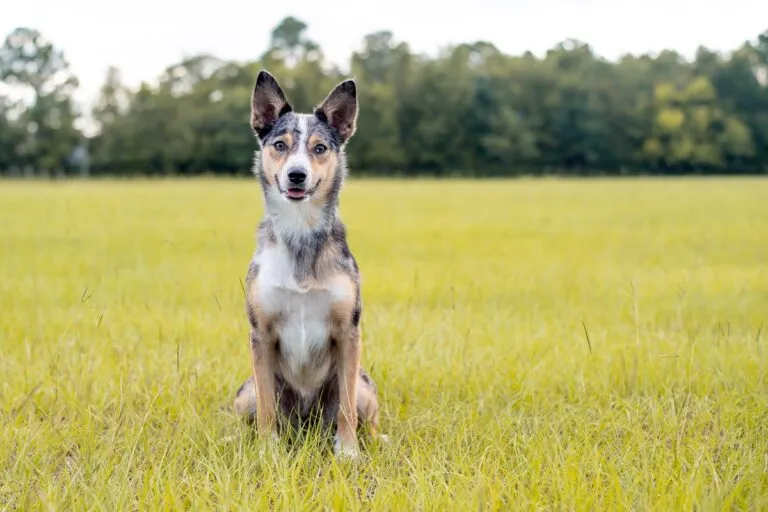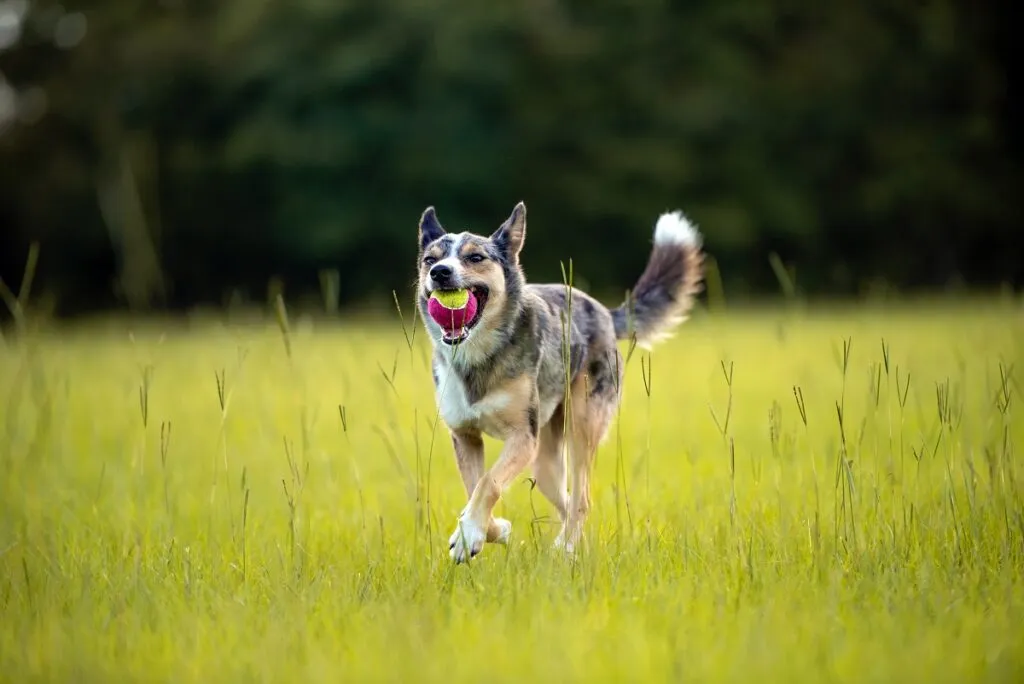Medium Size Poodle
The Australian Koolie is a diligent working dog from "Down Under", widely used for herding and driving livestock. It is also known by the somewhat misleading names of German Koolie or German Collie. Alternative spellings are Coolie and Coulie.

© Tanya / stock.adobe.com
The so-called Merle factor can lead to health problems in this breed. The Merle gene creates the coveted multi-coloured coat pattern, which consists of irregular spots
The Australian Koolie is a medium-sized dog. Since breeding primarily focuses on its willingness to work rather than its looks, appearances can vary greatly. The shoulder height typically ranges from 40 to 60 centimetres, and it weighs about 15 to 25 kilograms.
The body structure of the Australian Koolie is tailored to its primary task. Those bred for herding cattle are generally larger with a moderately strong bone structure, while Koolies for herding sheep tend to be smaller and more agile.
There are also regional differences. For instance, Koolies from the Australian state of New South Wales are generally small and stocky, as they often need to drive livestock out of dense brush. In northern Queensland, on the other hand, you will find larger, slender animals that can easily cover longer distances.
Their weather-resistant coat is usually short and tight or medium in length. Long-haired specimens with a lush undercoat are rare. The coat colour can be solid black, red or brown, but also bi-colour with white or black-and-tan.
Tri-coloured dogs in black or red with white and brown spots, as well as Koolies with Merle markings, are widespread.
Depending on the coat colour and pattern, the Australian Koolie can be easily mistaken for other Australian dog breeds such as the Australian Kelpie or the Australian Cattle Dog.
The Koolie’s ears are mostly pricked, but droopy or folded ears are also seen. Eyes may be blue, grey, or brown, or even two different colours, conveying an alert expression.
The Australian Koolie is a keen, highly intelligent herding dog that displays an impressive willingness to work. It effortlessly manages large herds of up to 1,000 animals, often making independent decisions.
This breed tends to be calmer than some other herding dogs. Generally, the Koolie is not prone to hyperactivity or nervousness. Upon command, it will stop its work and rest.
This hardworking, obedient Aussie forms a strong bond with its owner. However, it may be wary of strangers – aggressive behaviour is not in its nature.
Some Koolies exhibit protective instincts and display some territorial behaviour, making them suitable as watchdogs.
As a well-behaved family dog, the Koolie is only suitable if it is sufficiently tired out. An under-stimulated or bored Koolie will find its own job, such as herding children or smaller pets. For this reason, the breed is not necessarily recommended for beginners.
 © Tanya / stock.adobe.com
© Tanya / stock.adobe.com
Ideally, the Australian Koolie should fulfil its purpose of herding livestock. It thrives as the faithful companion of a shepherd or as a working dog on a farm.
Alternatively, the active Aussie can be physically and mentally challenged with dog sports like Agility or Flyball. Joint jogging or cycling sessions, long walks, and varied scent and brain games are also to its liking. Training as a rescue or therapy dog is also a possibility.
This robust, adaptable nature lover is best suited to a house with a garden in a rural setting. Its owners should have ample time to dedicate to it, as a dedicated working dog like the Australian Koolie should not be left alone for too long.
How demanding coat care is depends on the coat’s texture and length. Short-haired individuals require occasional brushing. Those with long hair and a lot of undercoat should be brushed more often, particularly during the shedding seasons in spring and autumn, when long-haired Koolies should be combed several times a week.
A nutritious, high-quality diet is vital for the health and energy of this agile herder. To maintain optimal performance, the Koolie needs nutrient-rich food.
In general, when calculating portion sizes, one should consider the animal’s age, weight, and activity level. Your veterinarian can provide guidance on this.
The Australian Koolie is known for being an extremely tough breed that is not overly susceptible to illnesses. Particularly in its homeland of Australia, there is a strong priority for healthy, high-performing dogs: unsuitable representatives are excluded from breeding. As a result, joint diseases like arthritis, elbow, or hip dysplasia are rarely seen.
A problem, similar to the Australian Shepherd, is the so-called Merle factor. The Merle gene creates the sought-after multi-coloured coat pattern consisting of irregular spots. However, mating two carriers of the Merle gene can lead to dead or seriously ill offspring.
Dogs that are homozygous for the Merle gene may be born blind or deaf. Many animal rights advocates consider breeding two Merle carriers a form of unethical breeding.
A responsibly bred Australian Koolie has a high life expectancy, typically living between 14 and 18 years.
The story of the Australian Koolie began around 1800 when numerous European settlers brought their sheep and dogs to Australia. Likely ancestors of the Koolie include British Smooth Collies with Black and Tan fur, as well as Old German Herding dogs. Later, other breeds such as Kelpies and Border Collies were crossbred.
Many German immigrants pronounced the word “Collie” as “Coolie”, resulting in the new dog breed being named the “German Coolie”. To emphasise the Aussie origin of the dogs and to avoid confusion with the Collie, the name Australian Koolie was later adopted.
To ensure the breed’s continuity, the Koolie Club of Australia was established in 2000. However, since there is no uniform breed standard, the Koolie has not yet been officially recognised by the FCI.
On a local level, like in Australia and America, this herding dog is already recognised as a distinct breed by some breeding associations.
Australian Koolies are still quite rare in Europe. Therefore, finding a reputable breeder can be challenging. Ideally, the breeder should be a member of the Koolie Club of Australia, and always place great importance on the health of the puppies and parent animals.
The few European Koolie breeders often maintain a waiting list. Those who have fallen for the compact Australian herder should follow their litter plans and express interest in advance.
In Australia, puppies of this breed cost around £700 to £1000. However, prices can be even higher in other countries.
The Australian Koolie is an energetic dog with a strong herding instinct. It is not recommended for people with little time or those who prefer a sedentary lifestyle. For those looking for an agile canine for herding work or dog sports, the balanced Australian Koolie will surely bring much delight.
| Special Features: | Working dog with a strong herding drive, primarily supporting Australian farmers, shepherds, and livestock breeders. Not recognised by the FCI. |
| Character: | Intelligent, independent, obedient, willing to work |
| Height: | 40-60cm |
| Weight: | 15-25kg |
| Coat: | Short or medium, rarely long |
| Colours: | Single, bi-colour, or tri-colour, often with Merle markings |
| Coat Care: | Easy to care for |
| Exercise needs: | High need for exercise |
| Beginner Dog: | Not recommended |
| Barking: | Enjoys barking |
| Lifespan: | 14-18 years |
| Common Illnesses: | Health problems like deafness or blindness mainly in dogs homozygous for the Merle gene |
| Price: | Starts at around £700 |
| Origin: | Australia |
Here are some purchase proposals curated by the zooplus editorial team
The products featured have been carefully selected by our editorial staff and are available at the zooplus online pet shop. The selection does not constitute advertising for the mentioned brands.
Fans of the Bearded Collie agree that those who aren't familiar with this dog breed simply have to get acquainted with it. And those who have experienced how a Bearded Collie bolts across meadows with its flowing fur, how it rolls around full of energy and joy and how it attentively and observantly takes into account its owners wishes become simply addicted to this original dog breed and its unique charm.
The Goldendoodle isn't a breed, but a pairing between Golden Retrievers and Medium or Standard Poodles. Marketed as a low-maintenance dog for allergy sufferers, this hybrid is enjoying increasing popularity amongst dog lovers, similar to the Labradoodle.